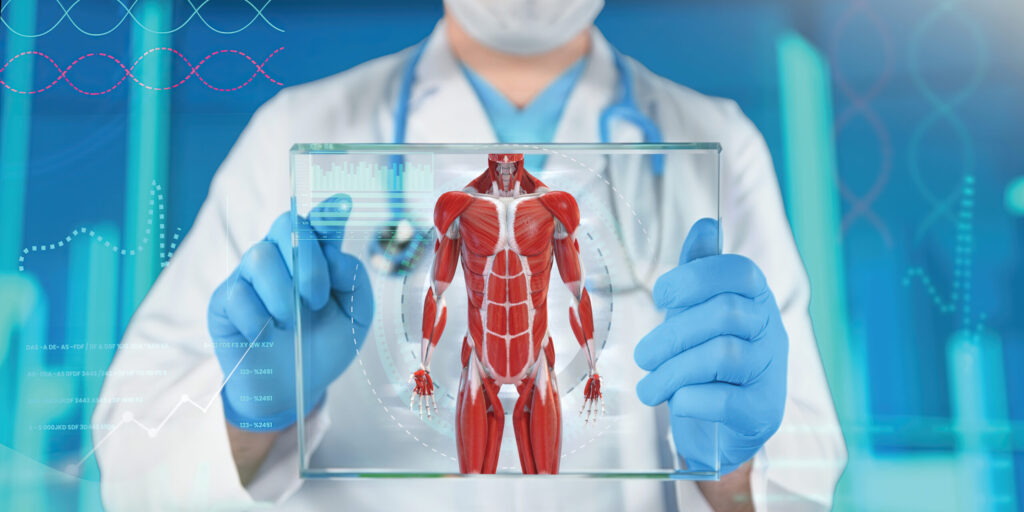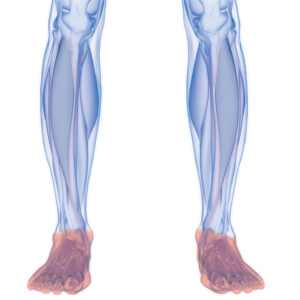
Understanding Myotonic Dystrophy (DM)
By Myrna Traylor | Monday, November 18, 2024
Myotonic dystrophy (DM) is a form of muscular dystrophy that was first identified by a German physician in 1909. The originally described version is now known as myotonic dystrophy type 1, or Steinert’s disease after the doctor who identified the symptoms. Another form of myotonic dystrophy, once known as proximal myotonic myopathy or PROMM, and now called myotonic dystrophy type 2, was identified as a separate disease in 1994.
Nicholas Johnson, MD, is a clinical neurologist and researcher at Virginia Commonwealth University and the Children’s Hospital of Richmond at VCU, as well as Director of the Center for Inherited Myology Research in the VCU School of Medicine’s Department of Neurology. He has a particular interest in inherited muscle disorders, including myotonic dystrophy. Dr. Johnson and his research team are excited about the likelihood that effective gene therapies could soon be available to treat DM and other neuromuscular disorders. Quest Media asked him to share his knowledge about DM.
What is DM?

Myotonic dystrophy type 1 is the most common form of muscular dystrophy in adults, affecting about 1 in 2,100 individuals, and is a multisystemic condition.
There are two types of DM. Type 1 (DM1) is the most common form of muscular dystrophy in adults, affecting about 1 in 2,100 individuals, and is a multisystemic condition. It is classically characterized by the development of muscle weakness that starts in the hands and feet; slowly progressive myotonia, which is the inability to relax your muscles; and early-onset cataracts that develop before the age of 50. DM1 also affects many other organ systems in the body, including the heart and lungs.
Type 2 (DM2) is less common than DM1. They share a development of progressive muscle weakness, but this time, the muscle weakness starts in the shoulders and hips. Patients with DM2 also develop early-onset cataracts and often have significant musculoskeletal pain. Heart issues may occur, but this is less common in DM2 than DM1.
When is DM typically diagnosed?
The diagnosis of DM1 and DM2 can be a little challenging, since either type can present with symptoms in any organ system. For example, some patients may develop stomach problems first or sometimes the pain in DM2 can look like fibromyalgia. Often, individuals with DM1 experience an approximate seven-year delay in their diagnosis. And it’s even more challenging for DM2, where the delay in diagnosis may be up to 14 years.
In the most severe form of DM1, symptoms can be present at birth or develop in childhood, but sometimes individuals don’t develop symptoms until their 40s, 50s or 60s. DM2 is also variable in terms of the age at diagnosis, but symptoms usually appear in early adulthood.
What causes DM?
Both types of DM are caused by changes in genes. In DM1, there’s a gene called DMPK where a section of DNA with the letters CTG repeats too many times. In DM2, the same thing happens with a different gene called CNBP, but the repeated section is CCTG. These extra repeats interfere with how proteins are made, leading to the disease.
These are genetic disorders that are autosomal dominant, which means that you only need to have one mutated copy to cause disease. (We all have two copies of each gene, one from each parent, and in this case inheriting one gene mutation leads to the disease.) They are also passed along to every generation, and there’s a 50% chance that future offspring will inherit the repeat expansion. It affects males and females equally.
DM1 also has a phenomenon called anticipation, where each child who inherits the gene mutation may have more repeat expansions than their parent, and therefore experience more severe symptoms. This difference in severity might also show up in siblings, where one has more severe symptoms than the other.
What are the typical symptoms?

DM1 is classically characterized by muscle weakness starting in the hands and feet.
One of the top symptomatic complaints, particularly in DM1, is daytime sleepiness and fatigue, which can be really debilitating. Oftentimes, we’ll treat patients with stimulants to try to help keep them awake. In both DM1 and DM2, people may need mobility aids. In DM2, we often need to provide medication to deal with the significant pain that can develop with the disorder. Apart from that, it’s important that individuals get regular cardiac monitoring for the cardiac heart rhythm disorders that can develop, and regular lung function testing for the pulmonary complications that can develop. From a combination of those issues, lifespan is usually shortened in DM1. In DM2, it’s not yet clear that lifespan is shortened because of the disorder.
How do clinicians help individuals manage the disease?
For DM1, we can treat people with anti-myotonia medications like mexiletine. Current management also includes ankle braces and walking aids, as they are needed, and monitoring for heart rhythm disorders, pulmonary compromise, and early-onset cataracts. There are a number of endocrinological abnormalities that can occur, such as underactive thyroid or an increased risk of diabetes, so we also check for those.
Are there new treatments on the horizon?
We’re very interested in the development of genetic therapies that have the potential to modify the course of the disease. Researchers are working on a way to help muscles absorb a special type of RNA (a molecule similar to DNA that is involved in protein production) by attaching it to an antibody or protein that can get inside muscle cells. Several companies have shown that this approach can fix the RNA issues involved in DM, reduce muscle stiffness, and improve strength. Specifically, Avidity Biosciences and Dyne Therapeutics have announced positive phase 1 and 2 results and are expected to move those products forward into phase 3 trials. It’s been an exciting time for therapeutic developments in DM1, and of course, many of us in the field are quite hopeful that the same therapeutic approach will be applied to DM2 in the future.
Are there any related diseases whose treatments might help with DM?
Another diagnosis that benefits from a very similar therapeutic technology is facioscapulohumeral muscular dystrophy (FSHD).
Myrna Traylor is a writer for Quest Media.
Next Steps and Useful Resources
- MDA’s Resource Center provides support, guidance, and resources for patients and families. Contact the MDA Resource Center at 1-833-ASK-MDA1 or ResourceCenter@mdausa.org
- Stay up to date on Quest content! Subscribe to Quest Magazine and Newsletter.
Disclaimer: No content on this site should ever be used as a substitute for direct medical advice from your doctor or other qualified clinician.




